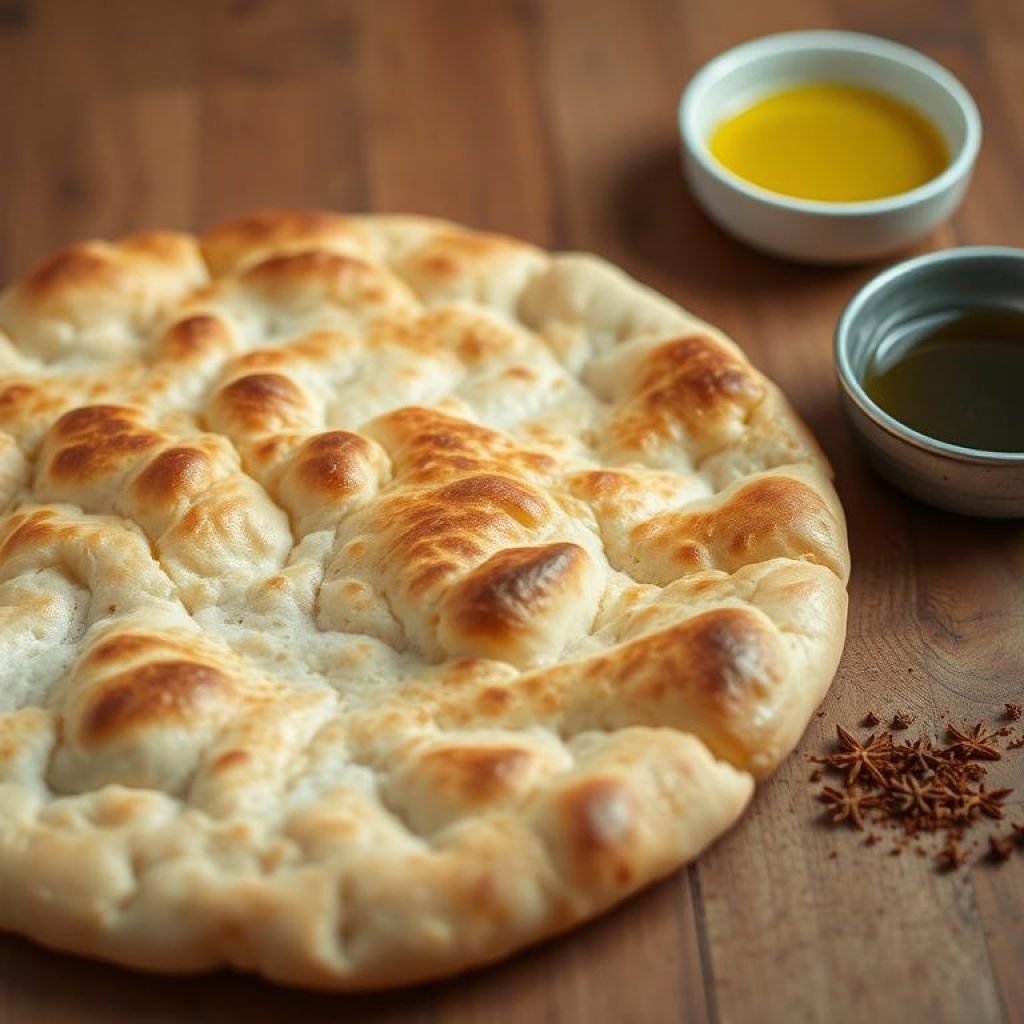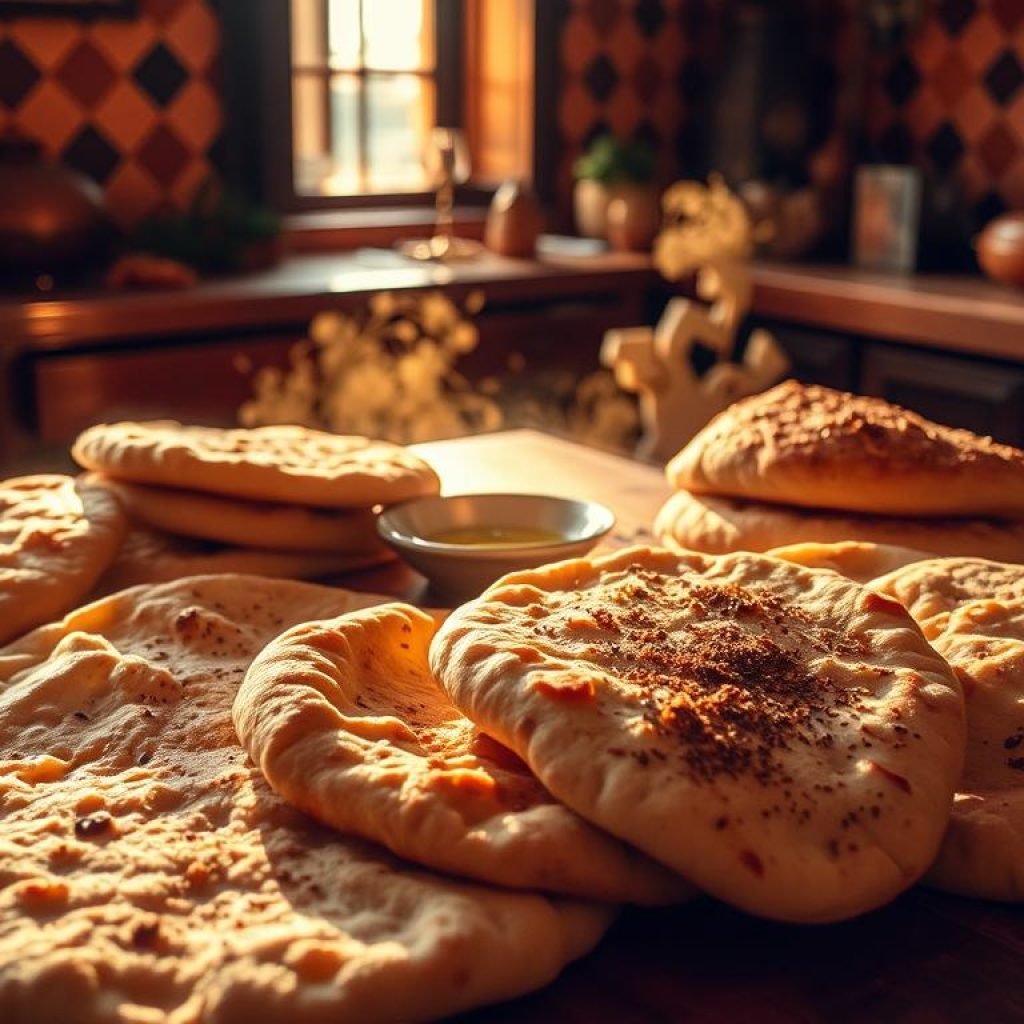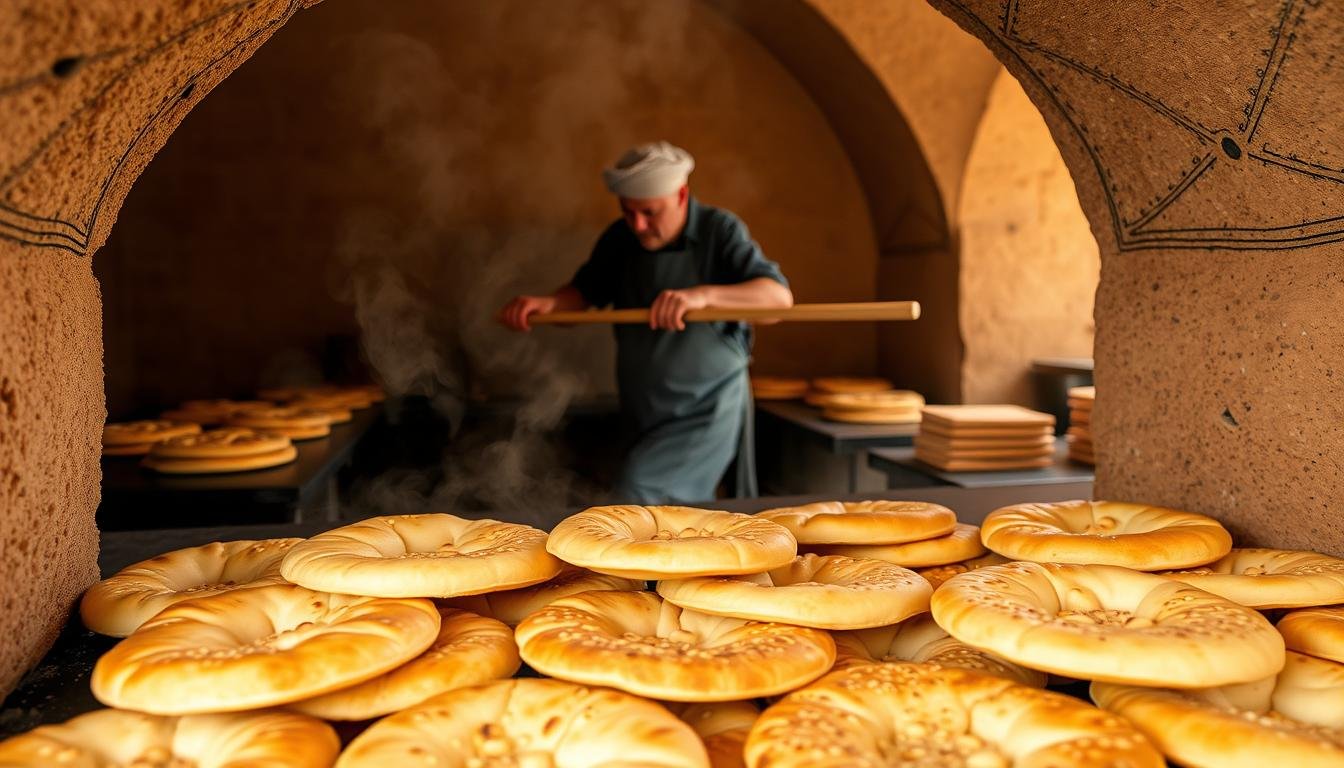Exploring Morocco’s vibrant streets, you might wonder how to best enjoy its famous food. Moroccan cuisine is a mix of traditional bread, homemade dishes, and exotic spices. Each dish, like bastilla and tagine, shares a piece of Morocco’s history and culture.
As you dive into Moroccan food, you’ll learn about the importance of bread. Khobz, batbout, and msemmen are key in every home. Whether you’re trying a traditional meal or street food, knowing local customs is key. So, how do you order food like a pro in Morocco?
Key Takeaways
- Traditional Moroccan bread is a staple in every meal
- Understanding local customs and etiquette is essential for a authentic dining experience
- Moroccan cuisine offers a wide range of options, from street food to fine dining
- Bread, including khobz, batbout, and msemmen, plays a vital role in Moroccan cuisine
- Homemade Moroccan bread is a testament to the country’s rich culinary heritage
- Moroccan bread, including traditional Moroccan bread, is an integral part of every meal
Understanding Moroccan Cuisine
Moroccan cuisine is a mix of history, geography, and culture. It focuses on authentic Moroccan bread, which is key to meals. There are over a dozen types of bread in Morocco, with more to find.
The traditional khobz bread is common on Moroccan tables. It’s often enjoyed with butter, honey, and mint tea. Other favorites include batbout, msemen, and rghaif, each with its own taste and texture. Many Moroccan bread recipes are available for those who want to try making it.
Some top breads in Morocco are:
- Khobz: a round semi-flat loaf
- Batbout: a soft and chewy bread cooked on a pan
- Msemen: a flaky and crispy bread made with a simple dough
Bread is a daily staple in Morocco, with many families baking or buying it. The saying “Looking for a piece of bread” means going to work. Moroccan cuisine’s rich flavors and aromas show the country’s warm hospitality and rich culture.
Where to Eat in Morocco
In Morocco, you’ll find many places to eat, from local spots to fancy restaurants. You can try traditional dishes or street food, like Moroccan flatbread. For a fancy meal, Morocco’s top restaurants offer a modern twist on old favorites, often with best Moroccan bread.
Bread is key in Moroccan meals, served with dips and sauces. Baked Moroccan bread is a must-have at home. Visitors can enjoy a wide range of tasty dishes, like tagines and seafood, with a warm Moroccan flatbread.
Some popular places to eat in Morocco include:
- Local restaurants and cafes, serving traditional Moroccan dishes like tagines and couscous
- Street food stalls, offering freshly baked bread, pastries, and other local specialties
- Fine dining restaurants, providing a sophisticated take on traditional Moroccan cuisine, often featuring baked Moroccan bread and other local ingredients

Whether you want a traditional meal or something fancy, Morocco has it all. With its rich food culture and fresh ingredients, it’s a dream for food lovers. Here, you can savor the best Moroccan bread and more.
How to Order Food in Restaurants
When you eat in Moroccan restaurants, knowing the local words and menu layout helps a lot. Traditional Moroccan bread is a big part of many meals. You can ask for homemade Moroccan bread to go with your food.
Moroccan food is full of rich tastes and many ingredients. To enjoy your meal more, ask your waiter for advice. They can help you pick dishes that include traditional Moroccan bread.
Here are some tips for ordering food in Moroccan restaurants:
- Be respectful of local customs, such as not throwing away bread, as it is considered impolite.
- Ask your waiter about the ingredients used in each dish to ensure you’re making an informed choice.
- Don’t hesitate to ask for recommendations or clarification on any menu items.
By following these tips and being mindful of local customs, you can have a rewarding and enjoyable dining experience in Moroccan restaurants. You’ll get to explore the rich flavors of Moroccan cuisine and enjoy traditional Moroccan bread.
The Street Food Experience
Exploring Morocco’s vibrant streets is exciting, and the local street food is a big part of it. Moroccan flatbread is a key item, often filled with different toppings. You can find the best Moroccan bread in street stalls, where it’s freshly baked.
To enjoy street food safely, follow some basic tips. Look for reputable vendors and avoid undercooked food. Also, make sure the food is prepared in clean areas. This way, you can enjoy Morocco’s authentic flavors without health worries.
Don’t miss out on grilled meats, savory pastries, and traditional soups. Moroccan flatbread, like msemen, is a favorite, filled with spiced meat and herbs. Trying the best Moroccan bread is a great way to start your street food adventure in Morocco.
For a safe and fun experience, keep these tips in mind:
- Choose vendors with lots of customers, as they usually serve fresh and popular food.
- Avoid stalls with poor hygiene or dirty equipment.
- Try different dishes to fully experience Moroccan street food.
Tipping and Payment Practices
Exploring Moroccan cuisine means knowing local customs, like tipping and payment. In Morocco, tipping is expected, with 10 to 15% for service staff. It’s a big part of the culture, like authentic Moroccan bread in hospitality.
Knowing how to pay is key to avoid trouble. Cash is best, but credit cards work in big places. A loaf of authentic Moroccan bread costs about 2 dirham. Making Moroccan bread recipes is also affordable.

When eating out, round up the bill or leave a few dirham as a tip. In fancy restaurants, 10% is common. Trying traditional Moroccan bread recipes adds to the experience. By following local payment and tipping customs, visitors can enjoy Moroccan cuisine more fully.
Ordering Food Online
Food delivery apps have made ordering food online easy in Morocco. You can get Moroccan bread delivered or picked up. Moroccan cuisine is famous for its bread, and now you can have it delivered.
Many apps offer homemade Moroccan bread and other local dishes. When you order online, pick trusted apps. Make sure to check the menu and prices first and use safe payment methods.
- Check the average delivery time for your area, which can range from 20-35 minutes for Mediterranean cuisine.
- Look for restaurants with high ratings, such as Zerza Moroccan Kitchen, which has 50 ratings and a 90% rating for food quality.
- Take advantage of contact-free delivery options and eligibility for free delivery through services like Grubhub+.
By following these tips and choosing the right apps, you can enjoy delicious Moroccan bread and other local dishes from home.
Dietary Restrictions and Preferences
Morocco has made big strides in catering to different diets. Now, many places offer vegetarian and vegan options. Even 10 years ago, vegetarianism was not well-known here. But today, menus often highlight vegetarian choices.
For those who need gluten-free choices, there are plenty of options. You can find gluten-free khobz or batbout in bakeries and restaurants. These are great alternatives to traditional Moroccan flatbread.
Traditional Moroccan meals often include Moroccan flatbread made from wheat flour. But for those with gluten issues, there are alternatives. In Marrakech, many restaurants offer gluten-free bread, including baked Moroccan bread made with gluten-free flour. Le Pain Quotidien Marrakech, for example, has a range of gluten-free products.
If you have dietary restrictions, learning basic phrases in Arabic or French helps. Saying “sans gluten” (gluten-free in French) can be very useful. Also, carrying a card that explains your dietary needs can make communication easier. With some planning, finding safe and tasty food in Morocco is easy, including best Moroccan bread for different diets.
- La Creperie du Marrakech, which offers buckwheat crepes
- Maison Sans Gluten, a 100% gluten-free bakery
Knowing what options are available and how to communicate your needs makes eating out in Morocco easy. You can enjoy Moroccan flatbread and other local dishes without worry.
Language Tips for Ordering Food
Exploring Moroccan cuisine can be fun, but language might be a challenge. Knowing Arabic and French basics helps you order and talk to locals. Saying “merhaba” (hello) and “shukraan” (thank you) shows respect for the culture.
In Morocco, Arabic and French are the main languages. But, many places, like tourist spots, have menus in English. Learning a few words in Arabic and French, like “Je voudrais une carafe d’eau, s’il vous plaît” (I would like a glass of water, please), is helpful.
Trying authentic Moroccan bread, like khobz, is a great idea. You can ask for recipes or suggestions from the locals. Speaking the local language makes your mealtime better and shows you care about the culture.
- Merhaba: Hello
- Shukraan: Thank you
- Je voudrais: I would like
- Ana ureed: I want
- Khobz: Bread
Learning these phrases and being open to new foods, like Moroccan bread, makes your experience better. It’s a fun way to enjoy your time in Morocco.
Cultural Etiquette at the Table
In Morocco, mealtimes are very important. Cultural etiquette makes these moments warm and welcoming. Traditional Moroccan bread is a must-have at every meal. It’s used as a utensil to pick up food.
This homemade bread is baked fresh every day. It’s a key part of Moroccan cuisine.
When you dine with locals, it’s important to respect their ways. For instance, throwing away bread is seen as rude. It shows a lack of appreciation for their hospitality. Instead, bread is used to clean the plate or get the last bits of food.
To feel at ease during meals, knowing the local customs is key. Here are some tips:
* Always use your right hand when eating, as the left is considered unclean.
* Only take food in front of you, unless the host offers you more.
* Follow the communal eating rules and don’t take food from someone else’s plate.
* Never throw away bread, as it’s a sign of generosity and hospitality.
By following these customs, you’ll have a great dining experience in Morocco. Enjoying traditional Moroccan bread or other local foods, remember to respect the table manners.
Special Dietary Requests
Morocco is quite welcoming to special dietary needs. Restaurants often make special dishes on request. They even have vegetarian versions of dishes like tajine.
For those with gluten intolerance, Moroccan bread is a good choice. It’s made fresh daily without preservatives. This makes it a better option than commercial bread.
In big cities, you can find Moroccan flatbread and other wheat-free items. Supermarkets have oat flakes, corn chips, and rice crackers. For the real deal, try the best Moroccan bread at a local bakery or market.
Lentil or bean hotpots are great alternatives to bread. You can find them at workers’ cafes and truck stops.
Learning key phrases in Arabic or French is helpful. Saying “I am gluten-free” or “I am lactose intolerant” can ensure your needs are met. This way, you can enjoy Moroccan food with confidence.
Making the Most of Your Culinary Adventure
If you want to dive deep into Moroccan cuisine, there are many ways to do it. Joining a culinary tour or cooking class is a great idea. You’ll learn how to make traditional Moroccan dishes, like the famous Moroccan bread, known as khobz.
But there’s more to explore than just cooking classes. Visiting the lively local markets and bazaars of Morocco is a must. Here, you’ll find the smells of fresh Moroccan bread, colorful spices, and the buzz of the vendors. It’s a chance to really feel the culinary heritage of Morocco and maybe even try making some dishes at home.




Comment (0)